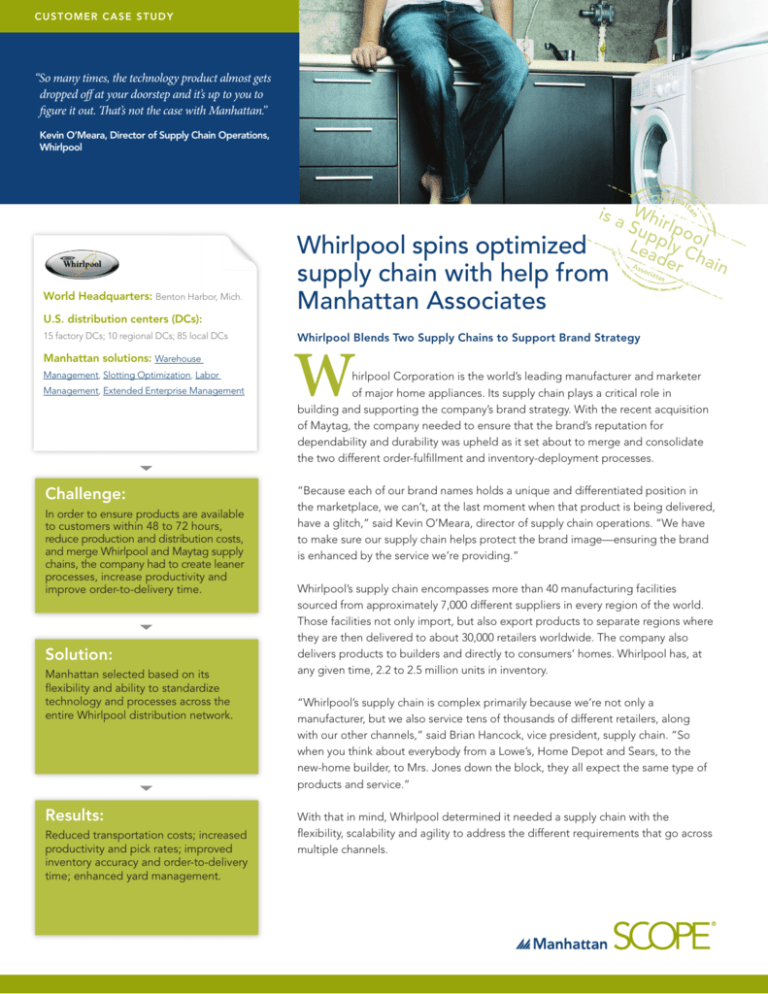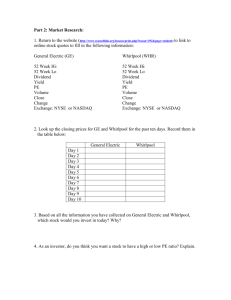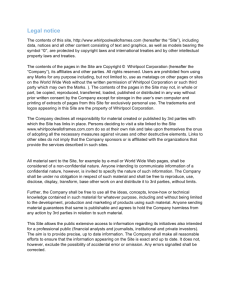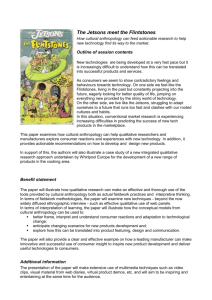
CU S T OM ER CASE STUDY
“So many times, the technology product almost gets
dropped off at your doorstep and it’s up to you to
figure it out. That’s not the case with Manhattan.”
Kevin O’Meara, Director of Supply Chain Operations,
Whirlpool
is a Whi
Sup rlpo
o
Lea ply C l
der hain
Ass
oc
World Headquarters: Benton Harbor, Mich.
U.S. distribution centers (DCs):
15 factory DCs; 10 regional DCs; 85 local DCs
Manhattan solutions: Warehouse
Management, Slotting Optimization, Labor
Management, Extended Enterprise Management
Challenge:
In order to ensure products are available
to customers within 48 to 72 hours,
reduce production and distribution costs,
and merge Whirlpool and Maytag supply
chains, the company had to create leaner
processes, increase productivity and
improve order-to-delivery time.
Solution:
Manhattan selected based on its
flexibility and ability to standardize
technology and processes across the
entire Whirlpool distribution network.
Results:
Reduced transportation costs; increased
productivity and pick rates; improved
inventory accuracy and order-to-delivery
time; enhanced yard management.
Whirlpool spins optimized
supply chain with help from
Manhattan Associates
iate
s
Whirlpool Blends Two Supply Chains to Support Brand Strategy
W
hirlpool Corporation is the world’s leading manufacturer and marketer
of major home appliances. Its supply chain plays a critical role in
building and supporting the company’s brand strategy. With the recent acquisition
of Maytag, the company needed to ensure that the brand’s reputation for
dependability and durability was upheld as it set about to merge and consolidate
the two different order-fulfillment and inventory-deployment processes.
“Because each of our brand names holds a unique and differentiated position in
the marketplace, we can’t, at the last moment when that product is being delivered,
have a glitch,” said Kevin O’Meara, director of supply chain operations. “We have
to make sure our supply chain helps protect the brand image—ensuring the brand
is enhanced by the service we’re providing.”
Whirlpool’s supply chain encompasses more than 40 manufacturing facilities
sourced from approximately 7,000 different suppliers in every region of the world.
Those facilities not only import, but also export products to separate regions where
they are then delivered to about 30,000 retailers worldwide. The company also
delivers products to builders and directly to consumers’ homes. Whirlpool has, at
any given time, 2.2 to 2.5 million units in inventory.
“Whirlpool’s supply chain is complex primarily because we’re not only a
manufacturer, but we also service tens of thousands of different retailers, along
with our other channels,” said Brian Hancock, vice president, supply chain. “So
when you think about everybody from a Lowe’s, Home Depot and Sears, to the
new-home builder, to Mrs. Jones down the block, they all expect the same type of
products and service.”
With that in mind, Whirlpool determined it needed a supply chain with the
flexibility, scalability and agility to address the different requirements that go across
multiple channels.
WHIRLPOOL SUPPLY CHAIN CASE STUDY | Warehouse Management, Slotting Optimization, Labor Management & Extended Enterprise Management
“Because each of our brand names holds a unique and
differentiated position in the marketplace, we can’t, at
the last moment when that product is being delivered,
have a glitch. We have to make sure our supply chain
helps protect the brand image—ensuring the brand is
enhanced by the service we’re providing.”
Kevin O’Meara
Director of Supply Chain Operations
Supply Chain Adjustments Are Needed to Put Chill
on Marketplace Challenges
The appliance marketplace has evolved during the last several
years and continues to change. Supply chains have, in turn, been
affected by shifts in consumers’ desires and needs, driven in
part by the economy as well as the more general availability of
different product mixes and multiple delivery channels.
According to Hancock, as the industry continues to change,
retailers want to carry less and less inventory, just as consumers
are becoming more demanding. “Mrs. Jones doesn’t want to
come in anymore and say, ‘It’s okay if my appliances show up in
two weeks.’ Eighty percent of our buyers have what’s called a
distressed buy. In other words, something’s broken—the washing
machine’s down or the refrigerator is not working. ‘Can you have
that there this afternoon,’ is the question.”
To successfully adjust to these marketplace changes, Whirlpool
would first have to address these challenges:
• To ensure products would be readily available to customers
within a newly established window of 48 to 72 hours, the
company needed to move to a segmented inventory strategy
supported by leaner processes; and
• As a large U.S. manufacturer, the company had to find a way
to lower costs in both production and distribution because it
couldn’t reproduce the labor savings other competitors
realized from overseas manufacturing.
“The biggest problems for most companies come from
their inability to bridge supply chain silos,” Hancock said.
“They separate order management, product development,
procurement and manufacturing from the final delivery. For our
supply chain professionals to deliver on our corporate promises,
we realized the way to attain the necessary efficiencies required
building seamless visibility inside and outside our warehouses.”
For Whirlpool, creating a more efficient supply chain also
meant altering traditional methodologies by consolidating
distribution centers.
WHIRLPOOL SUPPLY CHAIN CASE STUDY | Warehouse Management, Slotting Optimization, Labor Management & Extended Enterprise Management
“The biggest problems for most companies come from
their inability to bridge supply chain silos. They
separate order management, product development,
procurement and manufacturing from the final
delivery. For our supply chain professionals to deliver
on our corporate promises, we realized the way to
attain the necessary efficiencies required building
seamless visibility inside and outside our warehouses.”
Brian Hancock
Vice President, Supply Chain
Consolidation Brings More Complexity
During the Maytag integration, Whirlpool took its number of
major facilities from 47 down to 25, which allowed the company
to gain much needed consolidation. Yet, with each facility
measuring approximately a half-mile long by a quarter-mile wide
and boasting as much as 1.7 million square feet, consolidation
only brought more complexity.
“Because those facilities were so big, it just became more
complex inside those buildings as we consolidated,” Hancock
said. “We knew we needed to restructure the warehouses and
deploy the proper pick technologies to cut down on the number
of miles workers traveled inside the facilities.”
Manhattan Cooks Up Standardized Technology Across
Warehouses, Regions, Entire Network
Whirlpool wanted to standardize processes and technologies
across the entire network so the company selected Manhattan
Associates to assist with the integration.
Having worked with Manhattan previously, O’Meara knew the
company not only offered innovative supply chain solutions and
industry-leading experience, but also had a flexible organization
that could address Whirlpool’s unique needs.
“So many times, the technology product almost gets dropped
off at your doorstep and it’s up to you to figure it out,” said
O’Meara. “Not the case with Manhattan. The team conducted
a thorough needs assessment in order to understand the
problems and challenges Whirlpool needed to overcome. They
recommended the most viable solutions for our situation and
stayed with us through the entire implementation.”
WHIRLPOOL SUPPLY CHAIN CASE STUDY | Warehouse Management, Slotting Optimization, Labor Management & Extended Enterprise Management
New Efficiencies, Increased Inventory Accuracy and More
Uptime Build “Gourmet Kitchen” of Business Success
By using a combination of innovative solutions from
Manhattan Associates, including Warehouse Management,
Slotting Optimization, Labor Management and Extended
Enterprise Management, Whirlpool has achieved a number of
business successes:
•Eliminated 40 million travel miles between facilities, reducing
fuel costs and environmental impact;
• Reduced time associated with the pick process by 50%, thereby
speeding pick rates;
•Cut damage to products by 50%;
•Improved warehouse uptime to more than 90% toward
established goal of 99.9%;
• Seamlessly integrated two competing supply chains without
customer or trading partner interruptions;
• Built a more exact, real-time view of inventory inside the
warehouses which increased inventory accuracy;
• Gained warehouse efficiencies through integration of pick-pack
logic and process with more exact inventory counts;
• Improved order-to-delivery time; and
•Enhanced yard management capabilities.
Kevin Summers, Whirlpool’s global CIO and corporate
vice president, believes Manhattan has demonstrated how
technology is an enabler for business success. “The message
is: It’s not just technology. It’s not just business. It’s a partner
who brings both of them together that makes a successful
implementation,” he said.
Learn more about Manhattan Associates and our solutions:
North and South America +1 877.596.9208 • Europe, the Middle East and Africa +44 (0)1344 318000
Asia Pacific +61 (0)2 9454 5400 • www.manh.com
©
2013 Manhattan Associates, Inc. All rights reserved.







